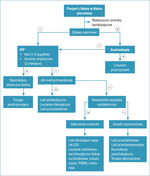W przypadku nieskuteczności leczenia objawowego lub uporczywych dolegliwości warto rozważyć modyfikacje terapeutyczne, jeśli to konieczne, po konsultacji z lekarzem na stałe zajmującym się daną chorobą.
Podsumowując, zawsze należy uwzględnić niekorzystny wpływ przyjmowanych leków i rozważyć ich modyfikację.
Na zakończenie warto zaproponować schemat postępowania w tej trudnej i różnorodnej grupie chorych (ryc. 1). Prosta próba polegająca na krótkotrwałej terapii dużymi dawkami inhibitorów pompy protonowej ma znaczenie nie tylko terapeutyczne, ale i diagnostyczne. Mimo braku badań kontrolowanych placebo i na dużych grupach pacjentów, w przypadku podejrzenia czynnościowego bólu pochodzenia przełykowego, nadwrażliwości przełyku i zaburzeń motoryki, w leczeniu proponuje się antagonistów wapnia, azotany, a nawet syldenafil. 80% pacjentów odnosi korzyść ze stosowania trójpierścieniowych leków przeciwdepresyjnych, dobre efekty przynoszą także terapie behawioralne.20 Niestety, ze względu na różne pochodzenie objawów, dużą komponentę psychogenną i nakładanie się innych chorób, leczenie jest trudne i obciążone dużym ryzykiem niepowodzenia.
The most common mistakes in managing the patient with chest pain – a gastroenterologist’s point of view
Abstract
Chest pain can be a serious symptom that, due to the potentially life-threatening implications, distresses both patients and doctors. Fortunately, in a large group of patients, these symptoms are benign in nature and, in spite of the sudden onset, they are caused by chronic, non-cardiac diseases. An appropriate evaluation of the patient’s history, physical examination, differential diagnosis and other work-up should lead to a correct diagnosis and further management. This article presents common mistakes made by physicians in referring patients with chest pain to the gastroenterologist.
Piśmiennictwo
1. Merskey H, Bogduk N. ISAP Part III: Pain Terms, A Current List with Definitions and Notes on Usage Classification of Chronic Pain, Second Edition, IASP Task Force on Taxonom. Seattle: IASP Press, 2012.
2. Bhuiya FA, Pitts SR, McCaig LF. Emergency Department visits for chest pain and abdominal pain: United States, 1999–2008. NCHS Data Brief 2010;43:1-8.
3. Foy AJ, et al. Comparative effectiveness of diagnostic testing strategies in emergency department patients with chest pain an analysis of downstream testing, interventions, and outcomes. JAMA Intern Med 2016; E1-E8.
4. Klinkman MS, Stevens D, Gorenflo DW. Episodes of care for chest pain: a preliminary report from MIRNET. Michigan Research Network J Fam Pract 1994;38:345.
5. Wong WM, et al. Attitudes and referral patterns of primary care physicians when evaluating subjects with noncardiac chest pain – a national survey. Dig Dis Sci 2005;50(4):656-61.
6. Mourad Ch, et al. Societal costs of non-cardiac chest pain compared with ischemic heart disease – a longitudinal study. BMC Health Services Research 2013;13:403(1-11).
7. Bösner S, et al. Ruling out coronary artery disease in primary care: development and validation of a simple prediction rule. CMAJ 2010;182(12):1295-1300.
8. Ebell MH. Evaluation of chest pain in primary care patients. Am Fam Physician 2011;83(5):603-5.
9. Fihn SD, et al. 2014 ACC/AHA/AATS/PCNA/SCAI/STS Focused Update of the Guideline for the Diagnosis and Management of Patients With Stable Ischemic Heart Disease. Circulation 2014;130:1749-67.
10. Katz PO, Gerson LB, Vela MF. Guidelines for the diagnosis and management of gastroesophageal reflux disease. Am J Gastroenterol 2013;108:308-28.
11. Fass R, Achem SR. Noncardiac Chest Pain: epidemiology, natural course and pathogenesis. J Neurogastroenterol Motil 2011;17:110-23.
12. Galmiche JP, et al. Functional esophageal disorders. Rome III: The functional gastrointestinal disorders third edition. McLean, VA: Degnon Associates, Inc, 2006.
13. Dąbrowski A. Objawy chorób układu pokarmowego. W: Gastroenterologia część I. Warszawa: Medical Tribune Polska, 2011.
14. Coss-Adame E, Rao SSC. A Review of Esophageal Chest Pain. Gastroenterol Hepatol 2015;11:759-66.
15. Kurek K i wsp. Wskaźniki jakości w endoskopii górnego odcinka przewodu pokarmowego – wytyczne grupy roboczej Polskiego Towarzystwa Gastroenterologii. Gastroenterologia Praktyczna 2014;3:30-48.
16. Dickman R, et al. Prevalence of upper gastrointestinal tract findings in patients with noncardiac chest pain versus those with gastroesophageal reflux disease (GERD) – related symptoms: results from a national endoscopic database. Am J Gastroenterol 2007;102:1173-9.
17. Kohn GP, et al. Guidelines for the management of hiatal hernia. Surg Endosc 2013;27(12):4409-28.
18. Bredenoord AJ, et al. Chicago Classification Criteria of esophageal motility disorders defined in high resolution esophageal pressure topography. Neurogastroenterol Motil 2012; 24(Suppl 1):57-65.
19. Malfertheiner P, et al. Management of Helicobacter pylori infection the Maastricht IV/ Florence Consensus Report Gut 2012; 61:646-64.
20. George N, et al. Review article: the current treatment of non-cardiac chest pain. Aliment Pharmacol Ther 2016;43:213-39.
